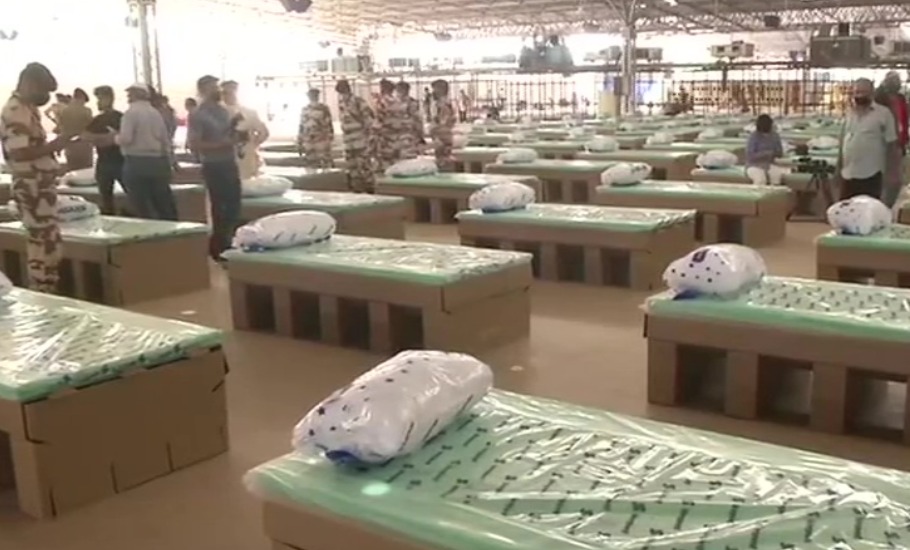
Forces prepared to face challenges: ITBP chief visits 10k-bed COVID-19 facility
Indo-Tibetan Border Police (ITBP) chief SS Deswal on Friday (June 26) visited the newly created COVID-19 care facility in New Delhi with over 10,000 beds and reviewed its preparedness, officials said.

Indo-Tibetan Border Police (ITBP) chief SS Deswal on Friday (June 26) visited the newly created COVID-19 care facility in New Delhi with over 10,000 beds and reviewed its preparedness, officials said.
“ITBP has gained experience in the last 4 months. Initially we managed a Covid quarantine center in Chhawla & then our 200 bedded hospital in Noida. Our medical team will help people in this crisis,” Deswal was quoted by news agency ANI as saying.
The large Radha Soami Beas establishment in Chhatarpur area of the national capital, as per the officials, will have two segments — a COVID care centre (CCC) where asymptomatic positive cases will be treated and a dedicated COVID healthcare centre (DCHC).
Delhi: DG ITBP visits #COVID19 Care Centre at Radha Soami Beas in Chattarpur. Says, "ITBP has gained experience in last 4 months. Initially we managed a COVID quarantine center in Chhawla & then our 200 bedded hospital in Noida. Our medical team will help people in this crisis." pic.twitter.com/3DOxiuIHGl
— ANI (@ANI) June 26, 2020
The CCC will have 90 per cent beds, while DCHC will have 10 per cent beds and the latter segment will also have an oxygen support system.
“Security forces & Armed Police forces are dedicated to the nation to deal with all kinds of situations. All challenges will be faced. Be it Army or ITBP they are dedicated to the nation for protection of integrity, sovereignty and borders of the nation,” ITBP DG SS Deswal said with respect to the various roles the armed forces play in India.
Related news: ITBP takes over Delhi’s 10,000 bed COVID-19 care centre
The border guarding force had taken over the centre on Wednesday after being directed by the Union Home Ministry to act as the nodal agency.
Deswal, the officials said, interacted with a team of doctors and paramedics who would man the facility and was updated about the medical and administrative protocols to be followed at the facility.
A team of over 1,000 doctors, nurses and paramedic staff of the ITBP and other paramilitary forces have been earmarked to work at the facility, a senior officer said.
“One thousand more ancillary and security staff will be deployed at the facility to enable it to operate smoothly,” he said, adding that the centre will also have 75 ambulances.
A huge assortment of air conditioners, fresh mattresses, pillows and toiletries has been placed at the facility named Sardar Patel COVID care centre and hospital.
ITBP Director General Deswal also “congratulated his team for the preparing the facility at a very short notice” in coordination with other agencies,” the officer said.
The total bed capacity at this centre may go up to 10,200.
The officials said this will be the largest COVID-19 care centre in the national capital as well as the country.
Related news: Kejriwal demands Indian Army, ITBP staff for Delhi’s COVID-19 centre
The south Delhi district administration is providing administrative support to the centre apart from the volunteers of the Radha Soami Beas.
The ITBP was the first organisation in the country to have created a 1,000 bed quarantine centre for coronavirus affected people.
The centre in Chhawla area of south-west Delhi has treated about 1,200 people, including 42 foreigners who were brought to India on special evacuation flights from Wuhan in China and Italy, after the COVID-19 outbreak a few months back.
It also created the first standard operating procedures for management of the pandemic among the various CAPFs and central and state police organisations.
The about 90,000 personnel-strong force is primarily tasked to guard the 3,488 km long Line of Actual Control with China. A good number of its troops along with Army personnel are at present engaged in fortifying Indian defences with the Peoples Liberation Army of the neighbouring country in the Ladakh area.
(With inputs from agencies)

